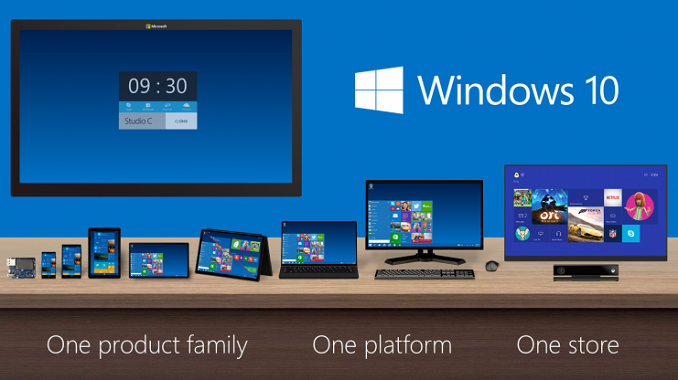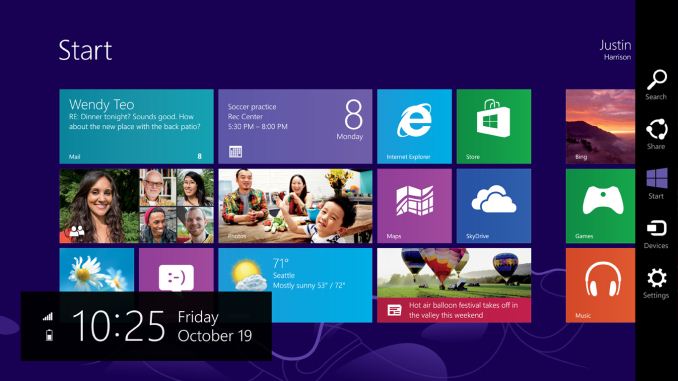Windows 10 Technical Preview First Impressions: The Return Of The Desktop
by Brett Howse on November 13, 2014 8:00 AM EST- Posted in
- Software
- Microsoft
- Windows 10

I’ve said this before, and I will reiterate it now. Windows 8, in general, is not perceived in a positive light. Not necessarily because of the lack of features, or even due to the touch first interface, but because from the start people did not buy into the paradigm. We can argue over why that was, and the specifics are likely different for every individual. But a big part of that was that Windows, which has had a familiar interface since Windows 95, had changed dramatically in look, feel, and general use. The traditional mouse and keyboard PC and notebook is a big part of the Windows user base, and especially at the beginning, Windows 8 did not cater to that crowd. While there were certainly improvements to the desktop, it was not enough to overcome the negative feelings of many users in regards to being productive on their PC. I say this as a fan of Windows 8.1, and I say this despite the positive review from this site. Windows 8 was an OS that worked, but had a steep learning curve that many people did not want to bother learning.
One of the biggest issues facing Windows 8 was just how much people liked Windows 7. Windows 7 was seen as the savior to Vista, and fixed many of its issues. But a lot of the initial problems with Vista were due to a major change in the driver model as well as the security model, which caused a lot of compatibility issues with older programs which expected administrator rights, as well as many hardware devices needed driver updates. With Windows 7, all of those changes were in the rear view mirror, allowing 7 to be a tweak of the overall UI and functionality rather than a rebuild of the OS from the ground up. With Windows 8, the move to touch first caused another dramatic upheaval. This time, rather than incompatible programs and hardware, we got a new Start Screen, a new runtime in WinRT, and a new app model with the Windows Store. For reasons that will never be made clear, the familiar start button was even removed, with the designers relying on hidden functions such as the hot corners to navigate around the OS with a mouse and keyboard. Luckily this change was reversed for Windows 8.1, with the start button returning, even if it still opened the Start Screen. With the Windows 8.1 Update, the system was made much more usable for a mouse and keyboard with the return of the menu bar to close apps, rather than dragging them down off the screen, and several other changes as well which brought the balance back somewhat to cover both touch interfaces as well as the mouse and keyboard.
 Windows 8 at launch in October 2012
Windows 8 at launch in October 2012
With Windows 8, Microsoft tried out an operating system which would work with a single interface across a breadth of hardware, from small form factor tablets, up to 30” monitor desktops. While they certainly succeeded in creating an interface that worked across all of those platforms, it was not ideally suited to any of them. With the tablet mode, the new Start Screen worked very well, and the charms menu and app switcher were fairly easy to use. But many of the settings and programs would be on the desktop, where touch only worked sparingly. Some desktop applications, such as Office, were created with a touch mode to increase the size of the onscreen elements, but overall the experience was subpar. Similarly, on the desktop, the touch interfaces were not ideal, and the hot corners certainly had issues especially on multi-monitor systems.
Windows 10 Technical Preview at launch
But now we come to Windows 10. Windows 10 is ditching the “One Interface to Rule them All” mentality, and moving to a more user friendly model of a single store across all platforms, and multiple interfaces to the same OS depending on the current usage model. We have not seen all of this in practice as of yet in the Technical Preview, but Microsoft has demonstrated their solution to this change in input mode with a feature they are calling Continuum.
The goal is that those that are on a keyboard and mouse based system will have the traditional start menu and desktop, with apps in windows, but if you are on a touch based device, or if you go on a 2-in-1 from keyboard to touch, the system will switch to the Windows 8 style start screen with full screen apps.
One of the keys to having this experience is an app model that allows a developer to target this different user interface paradigms. Microsoft’s solution to this is Universal Apps.











198 Comments
View All Comments
piiman - Saturday, November 15, 2014 - link
"The problem with that is they force you to use those features and become familiar with them before they take them out."How did they force you to use those features? I personally hate libraries and never use them I just open explorer and go to the location I have it saved, I'll do my own filing thank you.
taltamir - Monday, December 29, 2014 - link
1. Everyone told them this idea was stupid to begin with and they insisted on doing it anyways2. Beta testing is a thing, you can test features without putting them in the final version.
3. You can actually add an alternative option rather then removing the current method of doing things. If people got a choice between aero and that metro shit there wouldn't be a problem. But they removed aero because they didn't want people choosing to not use metro. They overestimated their power over users.
4. Having support for multiple APIs does not, in fact, make an OS unmanageable.
damianrobertjones - Thursday, November 13, 2014 - link
MS knows what people use and, in all honesty, libraries was probably one of those features that most users ignored. Businesses still used the older way of doing things (Direct folder re-direction) so just because YOU use something it doesn't mean the rest of the world does.P.s. I still use Libraries in Windows 8.1.
Ubercake - Friday, November 14, 2014 - link
Church. Updates aren't a new concept. This should be a non-issue at this point in technology. I've also had issues with printers showing as offline in Win 8 while all of my Win 7 PCs, iPhones and Android tablets can print to it. Printing is another thing that should be a non-issue. Also, something you occasionally see across Win installs (I've seen it in 7 and 8) is the login service not starting on a multi-user install. WTH is right. Logging in, printing, updates... All fundamental concepts. If you can't get these things right, you need to step away and revisit the basics before thinking you can start adding on.That being said, while previously being a large opponent of making the move to Win 8, I have forced myself to use Win8.1 Pro for the past couple of months on a souped-up workstation and the way I see it now is Win 7 - though stable and trusty - is a pretty old-school OS. I now see the metro screen as my very own portal page that will take me to my most-used apps and web resources. The other thing I like about the metro screen is the ability to just start typing to get to things like admin tools and the like. While I do most of my work in the desktop, the metro interface really is a quick way to get to things similar to a 'Jump page' or personal portal page.
Win 10 will hopefully get things right when it comes to those basics because the way I see it is if you can't get those things right after 40 years of designing operating systems, you need to revisit your process.
mebby - Friday, November 14, 2014 - link
How MS released Win8 and did not allow to boot in to desktop and keep Start Menu was a huge mistake. But I have used Win8/8.1 everyday and generally remain in the desktop. In many ways it feels like am using Windows 7. So it is not an ongoing disaster like many bloggers/journalist state. I stay in desktop... almost all day.But I also use a Win8.1 tablet everyday and really like the touch UI.
So I am also hoping that MS improves both the desktop and mobile experience in Win10. But I am doubtful. Seems like MS keeps changing direction and tripping over themselves even when they have good or great ideas.
Flunk - Thursday, November 13, 2014 - link
"Unlike apps written in .NET, WinRT is native code, which should result in better performance."This is actually not true. WinRT apps can be written in C++ (fastest), .NET (nearly as fast) or HTML/Javascript (slow). And the performance difference between C++ and C# specifically has shrunk significantly over the years, I might even argue that for desktop applications it doesn't really matter. WinRT is a good idea because it's fairly inclusive of different programming styles.
Flunk - Thursday, November 13, 2014 - link
Oops, I didn't intend to make that a reply.nevertell - Friday, November 14, 2014 - link
Whilst you can use the WinRT framework in different languages, the libraries and the framework itself is implemented in native code, hence execution will be fast.GatesDA - Thursday, November 13, 2014 - link
The rumor is that Win10 will be a free upgrade for Windows 7 users. The Technical Preview showed up as an option in my Win7 Windows Update, which adds credibility to the rumor.MonkeyPaw - Thursday, November 13, 2014 - link
Yeah, I think MS will be offering this for free or cheap for all legit Windows users (though I'm sure enterprise markets won't be free). Why? They need the Store to succeed, and Windows 10 will also be the best at platform sync, which should help sell all of MS's devices and services.